It’s amazing to see wild creatures in their natural homes,” says Gaja Rojec, as she sits next to a group of African penguins that don’t seem at all bothered by her presence. It is late January 2020, and the Slovenian film-maker is just one of about 800,000 people who have visited Boulders Beach on South Africa’s Cape Peninsula every year to get up close to these charismatic flightless birds.
At Boulders, just over an hour’s drive south of central Cape Town, African penguins swim, loaf around and breed within a few metres of visitors, who can even get into the water with them. Penguins normally nest on offshore islands, but this small beach is surrounded by houses which form a barrier to land-based predators such as caracal lynxes and baboons, making it a “pseudo island” where the birds feel safe. They have bred here since the early 1980s, and it’s now part of the Table Mountain national park.
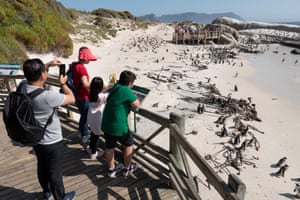
A visit to Boulders and its penguins is a high point of many South Africa trips, but the idyllic #bouldersbeach images that brighten more than 100,000 Instagram accounts mask a blunt fact: Spheniscus demersus is rapidly heading into extinction.
The species, which only breeds in South Africa and neighbouring Namibia, numbered about 1.5-3 million in the early 20th century. That dropped to 300,000 by 1956, and the numbers kept on falling. In 2018, just 15,000 pairs were found breeding in South Africa, and last year that slumped further to 13,300 pairs. About 5,500 pairs may still breed in Namibia, according to Namibian biologist Jessica Kemper, but no recent surveys have been done there.
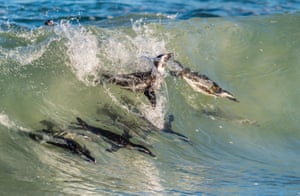
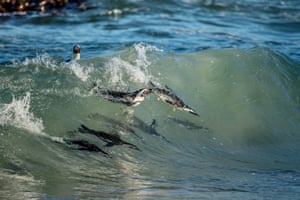
Because only about 2% of its former population remains, the species is classified as endangered on the International Union for Conservation of Nature (IUCN) red list. A 2018 study predicts the “functional extinction” of African penguins from the west coast of South Africa by 2035 if current patterns are maintained.
Christina Hagen of BirdLife South Africa says the main cause of the penguin’s dramatic decline in recent decades is the lack of nutritious small fish – sardines and anchovies – left in the right areas of the ocean. Decades of overfishing off the south-west coast of Africa, once one of the world’s richest fishing grounds and where the vast majority of penguin nesting islands are, have demolished many fish stocks.
“The jellyfish are thriving, though, and that’s a bad sign,” says Kemper of the Namibian waters where huge numbers of seabirds used to feed on fish. Ocean warming appears to have pushed many of the remaining small pelagic fish away from the west coast to areas off the south coast of South Africa, where there are very few islands.
Nesting penguins starve if there are too few nutritious fish near breeding colonies; the parents can’t hunt farther than 40km, at most, from the nest if they are to feed their young regularly. So Hagen and colleagues are pushing the traditional conservation envelope by trying to establish a new penguin colony on a stretch of the south coast of South Africa that has no offshore islands but is near some of the last remaining sardine stocks.
They identified a small headland in De Hoop nature reserve and turned it into a pseudo island by cutting it off from the mainland with a predator-proof fence. In January last year they stocked it with skilfully made concrete replicas of penguins along with speakers playing penguin calls to try to lure passing birds into nesting there.

While this could be considered a mild form of assisted migration, the often controversial practice of moving species to new areas so they can keep up with changing environmental conditions, in this case the penguins are not being moved outside of their natural range, but are being encouraged to create a new breeding colony about 100km away from the nearest natural one.
So far the fake penguins haven’t persuaded any wild birds to set up home in the new pseudo island, but Hagen will soon release young penguins from a Cape Town rehabilitation centre into De Hoop in the hope that this will lead them to breed there some years down the line, as penguins tend to breed at the places where they were raised.

But even if penguins breed at the new site and their youngsters leave the nest healthy and well-nourished, a large percentage still might not make it to maturity. Research has shown that the typical behaviour of young African penguins is not compatible with a warming, overexploited ocean.
Adult African penguins prefer to hunt in groups because it is far more efficient than hunting alone. These adults aggressively exclude inexperienced, first-year birds – who are easily identified by their blue-grey plumage – from fishing parties so they do not disrupt the hunt.
So the young birds move away until they are of breeding age. Researchers who satellite-tracked young penguins found that they tend to move long distances from their original colonies – sometimes more than 1,000km – mostly to cooler, nutrient-rich areas of the ocean that historically were rich in small fish, but where numbers are now low.
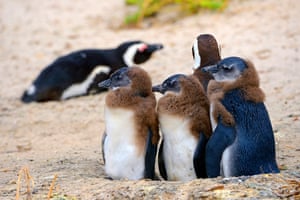
Young penguins that spend their first years off the west coast of southern Africa, where fish stocks have collapsed most seriously, are far more likely to starve than those that go south and east, where fish stocks are healthier. It appears that young penguins are falling into what scientists from the University of Exeter and the University of Cape Town refer to as an “ecological trap”, and this explains much of the overall population collapse. Even if birds breed at the new colony, their offspring might also fall into this trap.
Conservationists are now fighting on many fronts to keep African penguins alive, pointing out that thousands of other species are dependent on them and the cash they bring in from visitors. National park entry fees at Boulders Beach raised more than 72m rand (GBP3.2m) in 2018-2019, helping to make Table Mountain one of South Africa’s few parks to turn a profit and in turn subsididsing other parks in this megadiverse country. Since the Covid-19 outbreak and consequent shutdown of all South Africa’s national parks, this income has – at least temporarily – disappeared.
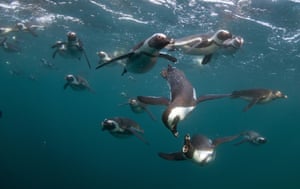
BirdLife South Africa is working with the South African government to declare no-fishing zones around penguin colonies and juvenile feeding areas, but the process is slow and complicated, says Hagen.
But even if fishing stopped in the areas where sardines and anchovies were once abundant, stocks might not recover. Ecological “state shifts” may have occurred, so that species such as jellyfish and gobies have moved in, for example, making it hard for sardines to reoccupy their place in the system even if they are no longer fished.
Hagen is not giving up on the birds, though. “I’m cautiously hopeful that if all the conservation measures we’re putting in place are successful, the penguins will survive,” she says.
Find more age of extinction coverage here, and follow biodiversity reporters Phoebe Weston and Patrick Greenfield on Twitter for all the latest news and features